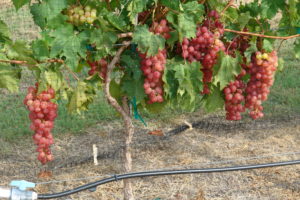New Texas Superstar introduced: Victoria Red grapes
- Writer: Adam Russell, 903-834-6191, [email protected]
- Contacts: Dr. Larry Stein, 830-278-9151, [email protected]
David Rodriguez, 210-631-0400, [email protected]
COLLEGE STATION – Texas grape growers face various obstacles, including disease, but an established variety has been recognized for its resilience, vigor and productivity as both an ornamental and edible plant – the Victoria Red grape.

Victoria Red grapes have been named a 2017 Texas Superstar plant by Texas A&M AgriLife Research and Texas A&M AgriLife Extension Service horticulturalists after years of field trials around the state.
According to AgriLife Extension horticulturists, to be designated a Texas Superstar, a plant must not only be beautiful but also perform well for consumers and growers throughout the state. Texas Superstars must be easy to propagate, which should ensure the plants are not only widely available throughout Texas but also reasonably priced.
The Victoria Red grape has grown successfully in the Victoria area for more than three decades and has succeeded where other grape varieties fell short because of their susceptibility to disease, said Dr. Larry Stein, AgriLife Extension horticulturist, Uvalde.
Stein said the most significant characteristic of Victoria Red is its sustained health, vigor and productivity in the coastal area of Texas, which has extremely high Pierce’s disease pressure.
The University of Arkansas, AgriLife Extension and Tarkington Vineyards near Victoria released the Pierce’s disease-tolerant grape variety. Evaluated as Arkansas 1475, the Victoria Red was bred in 1971.
The variety is a seeded grape with both large berries and clusters that are attractive and long with a bright red skin color, according to the Texas Superstar promotion literature. Average cluster weights at Tarkington Vineyards exceeded 1 pound.
Stein said clusters can reach 1 foot in length and berries are typically the size of 50-cent pieces.
“The Victoria Red has been growing around Victoria for more than three decades and there are many more grape varieties that have been introduced in that area that have died due to Pierce’s,” he said. “It’s a great variety for Texas and has strong aesthetic characteristics as an ornamental plant and as an edible table fruit.”
The Tarkington Vineyards’ location is approximately 40 miles from the Gulf of Mexico and has very intense Pierce’s disease pressure, according to the literature. Vines at this location were vigorous and productive for 20 years, while all other susceptible varieties died rapidly from Pierce’s disease.
Victoria Red is recommended primarily as a fresh-fruit cultivar in U.S. Department of Agriculture hardiness zones 7b or warmer. The variety is typically a two-seeded berry with an occasional third seed trace. In addition to yield and quality potential, Victoria Red has loose clusters, which appear to make it resistant to bunch-rot organisms common on more tightly clustered varieties.
The variety does best in well-drained soil with full sun and when spaced widely, 8-10 feet apart, said Stein. The plant may require iron chelate in high pH soils.
Victoria Red will grow luxuriantly, and it’s best not to over-fertilize the plant and prune to keep in bounds each year, he said. Bare root plant the variety in early winter or plant container-grown plants in early spring.
Stein said pruning typically includes removal of 90 percent of the wood that grew the year before.
“Leave some 1-year-old wood because that is what fruits, but you still want to make room for new growth and prevent over-cropping,” he said.
Stein recommends allowing the vines to grow on individual wires and “the higher the better,” though gardeners should consider pruning requirements. Vine arbors are also an aesthetic option to allow clusters to hang.
Gardeners should also prepare to address varmints, such as racoons, that will consume the fruit, Stein said.
Victoria Red can suffer some freeze damage further north, as it has routinely suffered cane and trunk injury in West and Central Arkansas.
However, it has been grown successfully in the Lubbock area, but obviously has some occasional freeze damage, Stein said.
Stein said a little fungicide might be in order during a wet year, but normal or dry years should not be a problem.
“It fits the bill for a Texas Superstar plant,” Stein said. “It’s tolerant to disease, productive and fruit quality is high. It requires a little management but is a very well-adapted plant with great aesthetics and flavor.”
Texas Superstar is a registered trademark owned by AgriLife Research, part of the Texas A&M University System.
David Rodriguez, AgriLife Extension horticulturist, Bexar County, said availability could be an issue but that Double A Vineyard in Frederick, New York,and Womack Nursery in De Leon, Texas have stock available.
“There are a limited number of suppliers that have Victoria Red right now,” he said. “We don’t want to recommend any supplier over another, but the last thing we want is to promote a plant and then have consumers not know where they can find it.”
A list of wholesalers and retailers who stock Texas Superstar plants and labels can be found at http://texassuperstar.com/.


